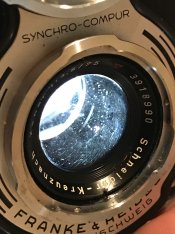If cost is important, go with the Rolleicord. A Vb in good to excellent condition will cost you about the same as a half clapped out Rolleiflex from the 1950s. For some insane reason I've not fathomed, Rolleiflexes of all vintages now sell for small fortunes, but Rolleicords get passed up on Ebay. Go figure...
They are also lighter, and bayonet I accessories are not really expensive. Last week in Kuching,Sarawak, I found two Softars in original Rollei leather cases for A$15. A once only bargain, I know, but they are out there.
The ergonomics can easily be worked out, with a bit of lateral thinking.
Following on from my earlier post (#18), I'm now in Sarawak, happily shooting with a Nikon D700 kit and my Rolleicord Vb with black-and-white film. I had six rolls processed in a Chinese photo studio this week, got the negatives back this morning. They are superb. Mostly Ilford FP4 and one HP5 shot in early morning light in the mountains. The scans look surprisingly fine-grained. Out of curiosity I asked the elderly shop owner what developer he used for the films, expecting to be told at the least, D76. No - Dektol! He explained his standard processing is done with Dektol 1+4 and high contrast scenes 1+5. I was, in a word, flabbergasted. The negatives look very sharp and finely detailed. Printing will tell, in time.
My 'cord kit is the camera, a lens hood, a UV filter, a yellow filter (and now the two Softars, which I may or may not use on this journey), a small exposure meter, of course film, and a generic brand grip as I've not yet found a strap with the Rolleicord lugs. Also a 16 exposure accessory kit I bought in Australi before I left, which cost me A$40. It reduces the per shot cost to something I consider more affordable, and the results are just as good. Not the 6x6 'square' but a pleasing 35mm-like 3x4 ratio, ideal for printing to 5x7 or 8x10.
Keeping it simple is the way to go. More bang for the buck, important nowadays to this retiree on a modest pension income, and lighter to carry.
. Right now I get sooooo nervous leaving my gx617 in the car when I travel. Hate carrying around my expensive equipment traveling.













